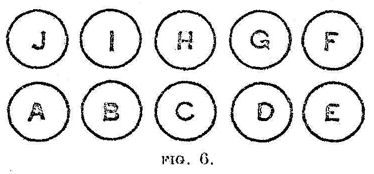lejla-gòbale (mancala)
G. Marin

[Page 506] Related to the Arabian m'tnqala, and to similar games found over the greater part of Africa and India.
Two parallel rows of 6, 8, or 12 holes are dug in the ground, and four balls of dry camel dung are dropped in each hole.
Each of the two players takes possession of one row. The first one to play takes the contents of the hole at the right end of his own row (A) and distributes one ball in each of the following pits: B, C, D, E; then he picks up the contents of the hole in which he has dropped his last ball (E), and distributes them in F, G, H, I, J; he distributes the contents of J in K, L, A, B, C; those of C in D, E, F, G, H, I; those of I in J, K, L, A, B, C. As his last ball drops in an empty hole (C), his turn of playing comes to an end; he takes as his winnings the last ball he has dropped (in C), together with the one which lies opposite (in J), and his opponent starts playing.
[Page 507] Both players are henceforth free to start their turn at whichever hole they like, providing it belongs to their own row. When a player ends his turn in one of his opponent's holes he takes nothing (aba·r, "famine ").When he ends it in one of his own holes, he looks at the opponent's hole which lies directly opposite; if the latter is empty he gets nothing (aba·r); if it contains 1, 2, 4 or more balls, he takes these, together with the one he has dropped last; but if it contains 3 balls, one of those is removed into the hole where his last ball dropped, so that each contains two balls; these two holes are now his ςù·r, and any ball that drops into either of them cannot be touched until the end of the game, when they are taken by the owner of the ςù·r.
When a player is unable to play, owing to the fact that all his holes are empty – with the possible exception of some ςù·r which cannot be touched - his opponent can take all that remains in his own row, always excepting the contents of any ςù·r which may belong to the first. The object of the game is to secure the largest number of balls.
bò·f ((Da·rò·d))

This game belongs to the same class as the preceding one. (Some of the details given below need conformation.)
Ten holes arranged in two rows are dug in the ground. At the outset of the game, each of the two players is provided with 20 stones, and places four of them in each of the five holes which are on his side. The first player lifts up the four stones from any one of his own holes, e.g. E, and distributes them, one in each of the following pits, F, G, H, I, then he takes the contents of the hole which follows next, J, and distributes them likewise in A, B. C, D. The following hole, E, being empty he finishes his turn, and takes as his winnings the contents of the next pit, F. Then the other player starts, by picking up the contents of one of the holes on his own side, and proceeds in a similar way. When the pit where a player has dropped his last stone is followed by two empty ones, he naturally gets nothing (bò·f).
As in lejla-gòbale, when a person whose turn it is to play, finds that all the pits on his side are empty, he forfeits all the remaining stones to his opponent.
As soon as all the holes are cleared, each player must replenish from his winnings the pits on his own side. The one who is unable to pay the full amount of four stones into each of his five pits must close down with sand or earth those holes which he cannot keep going; they are considered non-existent for the time being, but can be re-opened later should the owner increase his wealth.
The aim or the game is to reduce one's opponent's provision to less than four stones, in which case he is unable to continue the game, all his pits having to be closed.
Last update January 7, 2010
